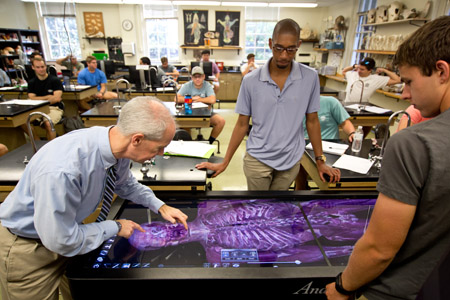 Hampden-Sydney's historic classrooms are reminiscent of a traditional educational environment. The close contact, individualized education, however, is accompanied by modern, cutting-edge technology. The most recent example, an Anatomage Table, is transforming the classroom experience to allow active participation in science courses.
Hampden-Sydney's historic classrooms are reminiscent of a traditional educational environment. The close contact, individualized education, however, is accompanied by modern, cutting-edge technology. The most recent example, an Anatomage Table, is transforming the classroom experience to allow active participation in science courses.
An Anatomage Table is a life-size, interactive digital anatomy table. Created to replace human cadavers, the table is used by many of the world's leading medical schools and institutions.
The $90,000 table is worth the expense for the
This expansion of resources makes it easier to get the course work and experience necessary to apply to graduate schools. The table is typically used in graduate and post-graduate education, therefore, H-SC students who are seeking to continue their careers in medical or physical therapy fields will be ahead of the curve. It allows for open-ended exploration of the human body, far surpassing the opportunities one would get with a cadaver.
Due to the interactive nature of the Anatomage table, classes have become noticeably more dynamic for all participants. Trinkle Professor of Biology Dr. Alex Werth explains that "anybody can hand out a textbook and go through a Powerpoint, but that wouldn't make me a good teacher. Frankly, it can be deadly dull and it's not a good use of classroom time."
Werth's goal is to influence his students, regardless of their major, to be active participants in life. "I want my students to learn how to think and not just answer questions, but know how to ask the right questions."
This outlook is the champion principle of a well-rounded liberal arts education - an idea Werth lives by himself. As a leading researcher of whale baleen, the plates in a whale's mouth that filter food, Werth could have worked in a research university. He chose instead to work at Hampden-Sydney College, a small, liberal arts college, so he could balance his research with teaching students. Along with those duties, he can also be found serving on many committees, training for his first marathon, and juggling daily life.
It was Werth who took initiative to ask the College administration for help and wrote a letter to alumni for help funding the table. Thanks to the generosity of the Hampden-Sydney community, and the dedication of Werth, the College could purchase the table. Paid for primarily by alumni donations, it can now be seen in Gilmer. After a short training, anyone in the community can use it, students and alumni alike.